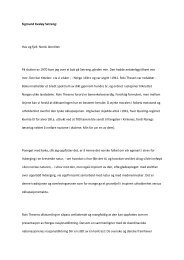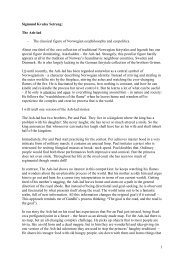The Healing Power of Nature - Norwegian Journal of Friluftsliv
The Healing Power of Nature - Norwegian Journal of Friluftsliv
The Healing Power of Nature - Norwegian Journal of Friluftsliv
You also want an ePaper? Increase the reach of your titles
YUMPU automatically turns print PDFs into web optimized ePapers that Google loves.
that, finally, if he tries to ignore its importance to himself, he does so at peril <strong>of</strong> his<br />
psychological well-being (Searles, 1960, p. 6).<br />
As mentioned earlier, children and nature is a current topic in a number <strong>of</strong> developed countries. An<br />
interesting historical perspective is that in the US in the 1960s and 1970s there also was a revival <strong>of</strong> the<br />
understanding <strong>of</strong> our need <strong>of</strong> nature and would probably be labeled as the first modern day green<br />
movement. In response Elwood Shafer <strong>of</strong> the Forest Service's Pinchot Institute <strong>of</strong> Environmental<br />
Forestry Research, worried about the impact on youth and children spending less time in nature,<br />
gathered pr<strong>of</strong>essionals from many different disciplines working with children. Representatives from<br />
local, state, and federal health, recreation, and park <strong>of</strong>ficials; and individuals working in the fields <strong>of</strong><br />
child development and environmental studies constituted most <strong>of</strong> the presenters along with some<br />
academics. <strong>The</strong> resulting 1975 proceedings <strong>of</strong> the Children, <strong>Nature</strong>, and the Urban Environment<br />
Symposium concluded that children need opportunities to explore wild places and to learn about nature<br />
for healthy maturation and are not having these opportunities. Along with ground breaking<br />
environmental protection legislation many school systems adopted environmental education programs<br />
and several curricula were developed including Project WILD, Project WET, and Project Learning Tree<br />
supported in part by federal agencies.<br />
Twenty-five years later the question about children needing and having opportunities to explore<br />
wild places and to learn about nature for healthy maturation was addressed again by Kahn and Kellert<br />
(2002) in their book Children and <strong>Nature</strong>. <strong>The</strong>y gathered ecologists, biologists, and psychologists<br />
academics and the findings were consistent with the practitioners <strong>of</strong> the 1975. Children were being<br />
denied the opportunity to explore wild places and to learn about nature (Kahn & Kellert, 2002). Kellert<br />
(2002) said that a child’s direct and ongoing experience <strong>of</strong> accessible nature is an essential, critical, and<br />
37




